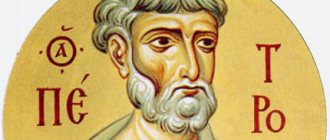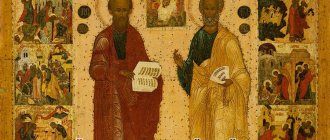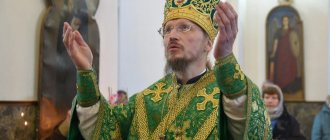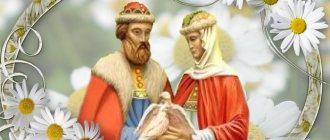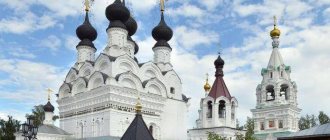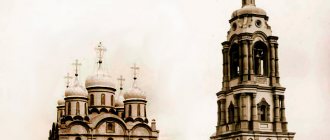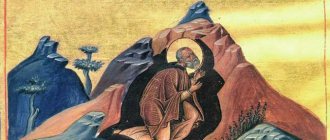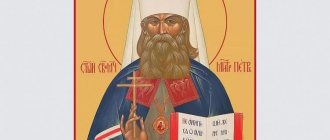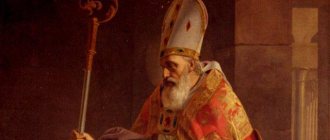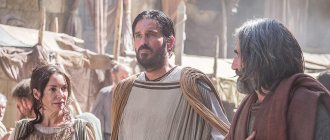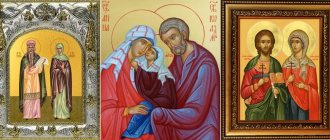“Let us honor Peter, the rock of faith, and Paul, the true teacher...”
The memory of the holy supreme apostles Peter and Paul is a great holiday celebrated on July 12 (June 29, old style). On this day, Peter's fast ends.
What date is Peter and Paul Day in 2022
Saints are often glorified on the day of their dormition. But historians do not agree on when exactly the two apostles suffered martyrdom. It is generally accepted that they died on the same day. In Chetyi-Minea St. Demetrius of Rostov states: these two events occurred within one year of each other.
Interesting fact
Therefore, the holiday is celebrated annually
July 12 according to the Julian calendar, on the day of the transfer of the relics, which occurred in 258 , as a tribute to the memory of their common martyrdom
. The holiday does not change - it is celebrated on the same day every year.
history of the holiday
The Day of the Holy Chief Apostles is dedicated to the memory of preachers of Christianity who accepted martyrdom for their faith. Their life paths are different, but in the Christian tradition the names of the apostles are closely connected, so the holiday is united.
Born into the family of a simple fisherman Jonah, Peter, who bore the name Simon before baptism, was called by Jesus along with his brother, the future Apostle Andrew the First-Called. Christ gave it the name Cephas (“stone”), implying that it would become a stronghold, a fortress, and the foundation of the future new church. The Aramaic Cephas in Greek sounded Peter, under this name the closest disciple of Jesus went down in history.
The Lord predicted that Peter was destined to renounce the Christian faith, and this actually happened, but later he atoned for the betrayal with his sermons and deeds.
According to Catholic tradition, Saint Peter is the first Roman pope (bishop).
As a missionary, Peter preached the Christian faith in Egypt and Greece, Asia Minor and Spain. In the book of the New Testament, two messages have been preserved, where the preacher strengthens converts in the faith and warns against temptations and false teachings. The disciple of Christ himself predicted his martyrdom, knowing that he would have to suffer for his faith. He was executed in Rome, where Peter, returning from his travels, was captured by supporters of Emperor Nero. The missionary was crucified upside down; he asked for this himself, considering it unworthy to be executed in the same way as the Teacher.
Paul had a completely different life path, who had the name Saul before his baptism. Born in the city of Tarsus, he was an opponent of Christianity and actively participated in the persecution of followers of the new teaching. While traveling to Damascus, Saul suddenly became blind, and when he heard the voice of the Messiah from heaven, he believed in him. Saul was healed of his blindness in Damascus, and almost immediately he began preaching, converting people to the new faith. After baptism, during his travels and missionary work in Cyprus, Saul took the name Paul, by which he is known as the supreme apostle.
Later, by imperial decree, Paul was captured, taken to Rome and tried. The court sentenced the preacher to execution, but since Paul was considered a Roman citizen, he was not crucified, but beheaded with a sword. The date of execution was June 29, on the same day Peter was executed. There is no exact data that the executions of the saints took place in the same year. According to the opinion of Dmitry Rostovsky, who wrote the “Cheti-Minea”, Peter and Paul were executed on the same day of one year, or with a difference of one year.
In 258, a significant event took place in Rome - the transfer of the relics of Christian martyrs. The event was timed to June 29 (in the new style - July 12), and since then the date has been considered the day of remembrance of the holy preachers.
Where are the relics located?
Peter was buried in the cemetery behind the circus grounds, in the arena of which he was crucified. His grave was revered by believers from the first days, and under St. Constantine the first Christian basilica grew here. At the burial site of St. Paul, the disciples left a sign, and two hundred years later the same God-loving emperor erected the papal cathedral of San Paolo fuori le Mura on this site. And a little earlier, in the 3rd century, the relics of both apostles were transferred and buried in the catacombs of St. Sebastian. of the Apostle Peter subsequently transferred to the Vatican, and of the Apostle Paul were transferred to the old basilica on Via Ostiensis.
Cathedral of the Apostle Peter in Rome. Once upon a time here, on Vatican Hill, the circus of the Roman Emperor Nero was located. On July 12, 66 (according to another version - in 64), Simon Peter was executed here. Its relics until the 1950s. were kept under wraps. From 1952 to 1965 Archaeologists worked in the tomb and extracted honest relics. Scientists conducted a study and found that the remains belong to a man over 60 years old who lived around the 1st century. Thus, the authenticity of almost 2000 years of revered relics was confirmed. Today any believer can worship them.
Two paths to Christ
If Peter was with the Savior from the very beginning, he went with Him all the way, showing cowardice only when Roman soldiers came for Jesus, for which he bitterly repented all his life. Paul did not belong to the 12 disciples at all and never saw the Messiah. Moreover, he was an opponent of Christians and even took part in the terrible execution of the first martyr in history, Stephen - he guarded the clothes of the executioners while they stoned the unfortunate man.
A simple fisherman from Galilee and a “Pharisee, the son of a Pharisee”, who knows the Jewish Law very well, are so different in origin, education and upbringing. And their paths in life are also different, but they have equally firm faith and one death: execution for preaching about Christ...
Peter's Path
Peter was fishing on the shore of Lake Galilee when Jesus called him. He and his brother Andrei were sitting in a boat. And when an unknown stranger walking by said:
“Follow Me, and I will make you fishers of men” (Matthew 4:11)
Duccio "The Calling of the Apostles Peter and Andrew", c. 1311. 42.7 × 45.5 cm. National Gallery of Art, Washington
Without hesitation, he was the first to throw down his gear and go to wander after Christ, leaving his fishing business, home, wife, mother-in-law...
- he was present when the Rabbi raised Jairus's daughter (Mark 5:35-43);
- boldly asked Him, walking on the stormy sea, permission to also walk on the waters (Mark 6:47-51);
- was among those with whom the Lord followed to the Mount of Transfiguration - Tabor (Matthew 17:1-6; Mark 9:1-8);
- Simon Peter is the leader among the 12, he is the most ardent and persistent of all: he expresses his readiness to go “to prison and to death” (Luke 22:33), at the Last Supper he does not allow people to wash their feet and persistently asks who will betray the Teacher.
- tries to protect Jesus in the Garden of Gethsemane from the soldiers who came to capture Him
By the way, it was Peter who first called Jesus Christ, which literally means “Messiah,” and recognized him as the Son of God, as Apostle Matthew testifies to this.
By birth he was called Simon. And the Savior gave him the name Peter (or Cephas, in the Aramaic version), saying:
“I tell you: you are Peter, and on this rock I will build My Church, and the gates of hell will not prevail against it; and I will give you the keys of the kingdom of heaven: and whatever you bind on earth will be bound in heaven, and whatever you loose on earth will be loosed in heaven.”
(Matt. 16:18-19)
Peter is a Greek name, translated as “stone”, a symbol of hardness.
The apostle was an ardent, brave man, he believed ardently... Sometimes he did not understand, sometimes he doubted, but his jealousy was great... But the fall was also terrible.
When the Teacher was taken by Roman soldiers, not long ago such a hot, fiery Simon denied Him three times. Then he grieved endlessly about it. The Evangelist John conveys the conversation of Christ with His disciple, the threefold questioning: “Simon Ionin, do you love Me?” Peter understands why the Lord does not call him Peter (a symbol of firmness), why he asks him three times (according to the number of his denials). And from the very depths of his contrite heart a cry is heard: “Lord! You know everything, You know that I love You! (John 21:15)
This love for God led him further through life until the very end.
He preached in the lands of Antioch, in the Mediterranean, in Egypt, but died in the Roman Empire. In 64 (according to the latest research in 66 or 67) in Rome, by order of Emperor Nero, he was destined for the same terrible death as the Teacher - crucifixion. But Peter considered himself too insignificant to die like Him. That’s why they crucified him upside down.
But, as if in mockery of the enemies, the building of the largest and first Christian cathedral in the world was erected at the place of execution in the 4th century, which still attracts millions of pilgrims to the Vatican.
Customs and traditions for Saints' Day
On the eve of the holiday, they do a general cleaning of the house, as well as renew worn-out furniture and repair what can be repaired. All water on St. Peter's Day is considered holy, so previously at dawn there was a tradition of going to the nearest stream or spring to wash three times. This action, according to legend, gives health and beauty to a person who washes himself at dawn for the entire next year. On Saints' Day, parishioners pray to the apostles for healing from fever or fever.
Sometimes on the holiday, believers stayed outside until dawn - to see the Sun rise from the horizon. In the evening, the villagers all went together to the edge of the settlement and burned fires until the morning. They cooked porridge, which was a common treat, and waited for dawn, having fun - singing songs and dancing. The tradition is due to the fact that there is a belief that if the first ray touches a person on the holiday, then good luck will accompany him for another year. This custom is called “watching the sun.”
In the South there was a tradition of “playing at the wedding.” They chose an artistic guy and girl who were the “groom” and “bride.” They were seated on a pair of decorated wheels and wedding traditions were carried out - from matchmaking and ending with the wedding. The action took all night. With the first rays of sunshine, the “bride” unraveled her braids and pulled off her sundress, remaining in her undershirt. After that, she began to run away from the guys chasing her. Meanwhile, the rest of the girls were having fun - dancing, laughing, singing. This ritual is dedicated to the Sun, which gives life to everything.
It is important not to be alone - there was a custom after the obligatory service in the temple to organize a feast dedicated to the holiday. Since the day is otherwise called Breaking the Fast, you can put any dishes on the table, since the fast has ended and there are no longer any food restrictions. There is also no ban on alcohol, but it should be consumed in moderation, as on any other Orthodox holiday.
Life of Paul
The path of Paul, a born Pharisee, a zealot of the Jewish law, which he knew from childhood, was completely different. Therefore, for him, the new teaching of the “preacher from Nazareth” is an insult to God, worthy of death. From an early age, young Saul (that was his name at the beginning) took an active part in the persecution of the first Christians.
Metropolitan Anthony of Sourozh writes that Saul persecuted Christians
“... not because he was an atheist, not because he hated faith; but because the idea that he had of God could in no way be combined with what he saw in Christ. He could not imagine a helpless God, a vulnerable God, a God as if defeated, despised, because he believed in a Holy God, inaccessible, shining with such glory that a person goes blind when he approaches Him. And he became a persecutor. But with all his soul he believed in God, he was directed towards Him, he lived by Him and for Him.”
In short, Paul might never have become an apostle. But the Lord had a different Plan.
The Conversion of Saul (Painting by Caravaggio, 1601) Saul almost accepts his vision
Once, already old enough, he was heading to Damascus, where the followers of Jesus found shelter. He set out to find and kill them. But on the way, he saw a cloud shining so unbearably that the young Pharisee lost his sight. And the light was followed by a Voice:
“Saul! Saul! Why are you driving me away?"
Blind Saul was brought to the city, where a good Christian offered a prayer for him, and his sight returned. Then he accepted Baptism and a new name. After which he went to preach Christian teaching around the world and converted many pagans.
Paul was also executed in Rome; the cruel Emperor Nero was also guilty of this.
Interesting fact
There is a legend that Nero set fire to Rome to write a poem about it, and blamed Christians for the arson. Historians refute this version: neither the emperor himself nor the people loyal to him set the city on fire on his orders. But the fire took place, and Nero found a convenient excuse to execute one of the main preachers of the new cult, the Apostle Paul.
Paul was a citizen (unlike Peter). Crucifixion, a shameful execution, was carried out only on slaves and criminals, who automatically lost their civil status. So the law did not allow killing the apostle in this way. He was executed in the same way as his fellow countryman, the Apostle James Zebedee from Bethsaida - by beheading with a sword.
Life of the Apostle Paul
Before turning to Christ, Paul's name was Saul. He was born in Tarsus, the capital of the province of Cilicia in Asia Minor. He came from the tribe of Benjamin, like King Seoul, in whose honor he received his name. He was a Roman citizen by birth, which gave him enormous privileges in those days, especially in the provinces. He probably also received the Roman name Paul (Latin for “small”) at birth, but began to use it only after turning to Christ.
The future apostle Paul was a zealous Pharisee who studied in Jerusalem with Gamaliel, the most authoritative Jewish teacher of that time. When the first martyr Archdeacon Stephen was stoned, Saul guarded the clothes of the tormentors. He hated Christians so much that he persecuted them anywhere and everywhere. On the way to Damascus, where he was going to persecute Christians, the Lord miraculously called him to apostolic service. Suddenly a very bright light shone and a voice was heard: “Saul, Saul, why are you persecuting Me?” He went blind and fell to the ground. The companions heard only a voice, but saw nothing. They led Saul by the hand to Damascus, where Ananias, one of the seventy apostles, taught him the faith of Christ and baptized him. Vision returned while immersed in water.
Saul became the Apostle Paul. Just as zealously as he had persecuted before, he now preached the faith of Christ in Arabia, Syria, Palestine, Antioch, on the island of Cyprus and in Athens. He founded many local churches, to which he sent his messages, which made up most of the book of the Apostle, read during the morning service in Orthodox churches.
The Apostle Paul, unlike Peter, received an excellent education. He knew well not only the Old Testament scriptures, but was also familiar with the Greco-Roman culture of that time: philosophy, literature, religion, and mastered the techniques of rhetoric. All this allowed him to freely polemicize with Greek philosophers in Athens. The preaching of the Apostle Paul was addressed primarily to the pagans.
When the Apostle Paul once again visited Jerusalem, the Jews accused him of leading the pagans to Solomon's Temple. The Sanhedrin court could not sentence a Roman citizen to death, so he was sent to Caesarea, where the Roman procurator was located in charge of the province. Taking advantage of the right of a Roman citizen to demand the trial of the emperor himself, the arrested Paul, in prison and under escort, travels to Rome. The trial lasted about two more years. Even while in prison, he had the opportunity to see the Apostle Peter and Roman Christians.
Extraction of the water source in the Mamertine dungeon. Fresco in the catacombs of St. Thecla. Second half of the 4th - first half of the 5th century. Rome
According to legend, the apostles spent the last days before their execution together in the dungeon of the Mamertine prison. There they baptized the prison guards Prokes and Martinian and 47 other prisoners. There was no water for baptism, but a miracle happened: the spring began to flow.
The apostles were led together to execution; they said goodbye on the Ostian road. Peter was crucified on Vatican Hill, Paul was taken outside the city to the Salvian waters. A Roman citizen was not supposed to be crucified on a cross, so his head was cut off with a sword. At the place where the head of the apostle fell, three springs gurgled, which have survived to this day.
The body of the Apostle Paul was buried in the same place. Emperor Constantine the Great built a church over the tomb. Subsequently, the basilica was expanded and decorated. The temple was destroyed in a fire in 1823. In 1854, a huge cathedral 120 meters long was built again.
Conflict: dispute and reconciliation
Chapter 15 of the book “The Acts of the Apostles” talks about the disagreement that arose in the Christian environment between the Apostle Paul, on the one hand, and the leaders of the Jewish community, on the other. This “no small competition” resulted in a long-term dispute about the possibility of saving the pagans. In particular, the Jews insisted that the Romans observe the Law of Moses: circumcision and kashrut (special food requirements).
Further, at the council in Jerusalem, Paul supported Peter, agreeing that uncircumcised pagans also need to be converted to Christ and not be required to fulfill the Mosaic Law. But later, preaching in Rome, meeting Jews who accepted Christ and continued to strictly adhere to the Law of their ancestors, Peter eats and drinks with the circumcised and begins to shun the uncircumcised.
Paul was outraged by this behavior of the apostle, which, in his conviction, contradicted the truth of the Gospel and openly denounced Peter in front of everyone: he said that he was doing this out of hypocrisy, emphasizing that Christianity is for everyone, and not just for the Jews. Peter did not respond to his brother’s reproaches.
Apostles Peter and Paul School or art. center: Central Rus'; Russian icon Beginning of the 16th century. Wood, gesso, tempera. 142 × 91 cm State Historical Museum, Moscow, Russia
Paul described the detailed circumstances of what happened in 2 Galatians:
“But when I saw that they were not directly acting on the truth of the Gospel, I said to Peter in front of everyone: if you, being a Jew, live like a pagan, and not like a Jew, then why do you force the pagans to live like a Jew? We are by nature Jews, and not sinners of the pagans; however, having learned that a person is not justified by the works of the law, but only by faith in Jesus Christ, we also believed in Christ Jesus, so that we might be justified by faith in Christ, and not by the works of the law; For by the works of the law no flesh will be justified.”
(Gal 2:14-16)
It seems the irreparable has happened - a conflict. However, John Chrysostom , who devoted an entire conversation to this topic, explains that there was no conflict:
Christ, as a general, dividing his officers by branch of the army, gave the pagans to Paul, and the Jews to Peter. But the Jews were in no hurry to deviate from their law, and Peter was afraid to wean them from their old habits, so as not to tear out the weak shoots of faith in Christ along with the weeds. Paul, leading the pagans, helped his brother.
If he wanted to reproach Peter, he would not have done it in public, but would have come and said it in private. But he reprimands him in front of everyone: both pagans and, most importantly, Jews. Thus, reproaching not the great apostle, to whom he did not consider himself an equal, but the inert Jews who shunned other Christians. And Peter’s silence was not cowardice at all, but a worthy response. Meanwhile, the apostles had deep respect for each other, and they had one goal - to make the new Church Universal.
Church rituals and the meaning of the holiday
In Orthodoxy, the celebration is considered one of the great ones; it is preceded by the Fast of Peter. Stichera for divine services were written in the 7th-8th centuries, their authors were: Patriarch Herman of Constantinople, St. John of Damascus, St. Cosmas of Mayum and other hymnographers.
Many believers strive to visit cathedrals on July 12 and take part in divine services; they confess, take communion and sing akathists. Priests performing rituals wear clothes of white or yellow shades.
- Some of the prayer chants are addressed simultaneously to two apostles. Here the Omnipotence of God is glorified, who endowed Peter with firmness of character, and Paul with great intelligence, and both with the ability to truly preach and drive away the lies of godlessness. The Church calls the apostles its teachers.
- In the stichera to Peter it is sung that Christ corrected his threefold denial of God. The Apostle established himself in the Omniscience of the Father and confessed his great love to Him. The Messiah commanded Peter to become the shepherd of the Christian people and ask God for mercy on sinners.
- The stichera to Paul glorifies his courage and patience for the Savior. The chanting believers ask the saint to pray for all humanity.
- On the eve of the celebration, proverbs are read, and at matins, canons addressed to the holy disciples of the Son of God are sung.
The Church calls the saints supreme because they worked more than others in spreading the knowledge of the descent of the Messiah. Peter carried the good news in the lands of Judea, and Paul among the Gentiles. In addition, Orthodoxy claims that there is only one head, and this is Christ, and the apostles are only ministers.
About the other apostles of Christ:
- Prayer to the Apostle and Evangelist Matthew
- Prayer to Saint Apostle Philip
- Icon of the Apostle John the Theologian
On the day of remembrance of Peter and Paul, we remember their martyrdom and transition to true life next to the Creator. These disciples are real lights of religion, thanks to them Christianity spread throughout the entire earth.
In baptized Rus', churches were built in honor of the apostles. The oldest, built by the princes and consecrated by Bishop Simeon, is located in Smolensk. The church is made in the traditions of Byzantium and Kyiv. Several churches are located in Veliky Novgorod, Kozhevniki, Slavna, Bryansk and Pskov.
On a note! The day of veneration is not part of Peter's Fast, but the degree of strictness in food on July 12 is only relaxed. The Church prescribes that during the Lenten period one should refrain from eating meat and dairy products, as well as fish on Wednesday and Friday. Wine is only allowed on Saturday and Sunday. Depending on the date of Easter, Petrov's fast can last from 8 to 42 days.
Folk traditions
July 12 is revered as fishermen's day, because Peter was involved in this craft. This date opens the summer fishing season and ends the spring.
- July 12 was considered the beginning of grass cutting and it was believed that the apostles would protect the areas sown with bread from the elements and parasites.
- On the eve of the celebration, village youth went to the fields to spend the night here and watch the dawn. It was believed that on this day the sun shines with special tints and is incredibly pleasing to the eyes.
- In some villages, people traditionally washed their faces with “petroleum” water and drank intoxicating drinks. Round dances, celebrations and dances were held.
- The peasants observed Peter's Fast very strictly. Before the celebration, festive dishes were prepared.
Iconography of the apostles
The tradition of depicting these saints in Rus' came from Byzantium. Domestic masters followed the methodology, but added new elements to the art.
- In early iconography, the apostles were depicted together and frontally, facing each other. This symbolized the creation of the New Testament Church. The first images were usually associated with the theme of establishing Christian teaching on earth.
Apostles Peter and Paul - In the icon, Peter extended his right hand in a gesture of prayer, and in his left right hand he held a scroll. In the hands of Paul, believers observe a book - a traditional attribute of a sage, this reminds us of his 14 holy letters.
- The figures of Christ's disciples look slender, but evoke a feeling of monumental resistance to human passions. The silhouettes (due to the cloaks) expand downward, and their position is dispersed vertically in the middle of the canvas. Their feet practically touch the ark, and their halos touch the upper edge of the icon. At the same level with their heads there is a heavenly semicircle with the face of the Savior, which symbolizes the extreme closeness of the disciples to God.
Why are Saints Peter and Paul the supreme apostles?
All of Christ's disciples carried His word, performed miracles for His glory, and died for Him. Why is Peter called supreme, and even more so, Paul, who was at first against Christians?
Firm faith, a burning heart with love for the Lord, a desire to serve Him with all their lives - qualities that provided them with authority in the early Christian community and determined their supreme role in the history of the Christian Church.
Their merit lies in the fact that it was these two apostles who were more concerned than others about organizing the earthly affairs of the Church. To carry the faith and convert pagans is a great, noble mission. But someone must take care of their “daily bread.” The apostles Peter and Paul dealt with, in modern terms, administrative issues, the economy, life and morality of the first Christian communities.
Gorodushki
Nowadays, the nightly festivities of young people have acquired a slightly different shade. In big cities this tradition is now completely forgotten, but in small towns and villages, in some places, it is still alive. The point is that on the night of July 12, teenagers organize so-called “towns” or “shuharilki” - they play pranks in every possible way.
Important: this type of entertainment is highly discouraged by the church and the law. For some, completely unchildish pranks, you can pay: a fine or even a real sentence of up to 5 years.
What do they do in the towns? Traditionally, they play pranks, but without going beyond certain limits of what is reasonable. That is, if you trample strawberries in a neighbor’s garden, then you can answer for it before the law. And from a moral and ethical point of view, you yourself understand what such an act looks like.
The most important thing is that such pranks do not cause any material damage. Therefore most often:
- blocked roads;
- they placed a bucket of water over the door;
- they placed a cow's dung on the threshold;
- they covered the windows in the house;
- They tied a pebble to a string and knocked on the window.
Let us note that it was not forbidden to drive with a whip those who were caught doing this. Therefore, those who did not want to participate in such fun sat at home and guarded their plots.
This tradition is most popular in the Tula, Kaluga, Ryazan and Oryol regions.
Icons
In iconography, there are different options for depicting the apostles. We often see them in pairs. Peter has a short haircut and a gray beard, and Paul has a dark beard and high forehead characteristic of Jews. The first one holds a scroll in his hands, the second one holds a book.
Apostles Peter and Paul. Karl Zolotarev.
You can also often see a key in Peter’s hands. This is a symbol of his special mission - to be the gatekeeper at the Gate to the Kingdom of God.
Sometimes the saints stand opposite each other, sometimes they look at the viewer. But they can also be seen very close, in brotherly embraces.
They are also written separately. But at the same time they look the same as on paired icons.
How do the apostles help?
They pray to the Holy Apostles:
- if they want to strengthen their faith;
- bring back the apostate to the faith;
- to convert a non-Christian;
- get rid of mental or physical illness.
You can pray separately to Peter or Paul or to both of them at once.
It is also believed that Peter is the patron saint of sailors and fishermen, since during his life he was a fisherman before becoming Jesus’ assistant. St. Paul helps achieve learning results because he was a learned man.
Description of the painting by artist El Greco
Images of Peter and Paul often appear in both Western and Russian painting. One of the most famous paintings was painted by the Spanish master El Greco . It’s amazing how, through perspective and color palette, the artist managed to show the difference between the characters of the two apostles, their inner essence. In his canvas, the central figure seems to be Pavel, who is depicted as a colorful, rather young man in bright scarlet clothes. He looks at the viewer and leans on the book. Many modern researchers of El Greco’s work believe that the Apostle Paul dominates the picture, while Peter looks more modest, and repentance is visible on his face.
Interesting fact
Others believe that two equally strong and wise disciples of Jesus Christ are presented. Only Saint Peter is immersed in inner prayerful contemplation, while Saint Paul, with a movement of his hand, points to the books lying in front of him. It is supposed to be the Holy Gospel and the 14 Epistles of which he is the author.
In this reading of the picture, it becomes clear what exactly the Greco-Spanish artist wanted to convey: his vision of the Christian Church - a combination of knowledge that is drawn from the New Testament with prayer addressed to the Lord.
Apostles Peter and Paul. Around 1587-1592, Oil on canvas. 121.5 × 105 cm. The work is by the famous Spanish artist El Greco. Domenikos Theotokopoulos, who took this pseudonym, was Greek by origin, native of the island of Crete. The famous painting can be seen in the Hermitage of St. Petersburg. It is striking, in many ways reminiscent of an icon: it amazingly combines the artistic style inherent in the Renaissance era and elements of Orthodox iconography. However, the paradox can be explained: El Greco, while living in Crete, studied with the Orthodox Greek icon painter Michael Damaskinos. And although the artist’s entire family belonged to the Roman Catholic Church, he painted his canvases in the Greek Orthodox style.
What you can and cannot do on St. Peter's Day, what you can eat
On the day of remembrance of the apostles, the church imposes many prohibitions. The priests also give their recommendations on how to celebrate this holiday:
- visit church and attend the festive service;
- confess and receive communion in order to properly complete the fast;
- prepare fish dishes to attract wealth and happiness;
- cook borscht using fresh vegetables so that there is no hunger in the new year;
- prepare buns filled with cottage cheese or fruit;
- visit relatives and friends.
On a note! On Peter's Day, housewives tried to show the well-being of the family. To do this, they set a rich table with pancakes and loaves. Mandatory dishes are flatbreads and fish soup. They were the main food of the apostles.
The holiday should be spent cheerfully and joyfully, with good thoughts and a positive mood. There is no place for sadness on this day. There are several prohibitions that every Orthodox Christian must observe:
- Weddings and weddings are not held on July 12;
- Physical work around the house and in the garden is prohibited;
- show aggression and conflict with other people;
- wish evil upon others;
- swim in rivers and lakes, as there is a high risk of drowning;
- drink a lot of alcohol.
To be Christed - what does it mean, how to properly christen
When is Easter in 2022, what date do Orthodox Christians in Russia have?
Other paintings
Among other works of painting, Caravaggio’s works “The Conversion of Saul” and “The Crucifixion of the Apostle Peter” are famous. Both, although the first tells about a miracle, make a very gloomy impression. However, this is the manner of this artist.
Caravaggio "The Crucifixion of St. Peter"
Rembrandt created quite heartfelt images, depicting the Apostle Paul in prison, as well as the conversation between the two apostles.
"Conversation of the Apostles Peter and Paul." Rembrandt.
Among Russian painters, one can note the painting by V.I. Surikov “The Apostle Paul explains the dogmas of faith in the presence of King Agrippa, his sister Berenice and proconsul Festus,” the title of which speaks for itself.
The painting “Where are you going, Lord?” was written by the Italian painter and engraver of the Bolognese school Annibale Carracci 7 years before his death - in 1602. The plot of the picture is based on that set out in the apocryphal legend - “The Acts of Peter”.
12th year of the reign of Emperor Nero. Terrible persecution of Christians in Rome. The arrest of St. Peter is expected any day now. His followers, realizing that the saint will die on the cross, beg him to escape. Peter yields to their persuasion, at night he leaves the city along the Old Appian Way... and meets Christ outside the city gates. "Domine, quovadis?" (“Lord, where are you going?”) – Peter addresses the Savior. “Since you, Peter, are leaving My people, I am going to Rome for a new crucifixion,” Christ answers. Each person has his own path in life, his own sometimes very difficult choice. Peter humbly accepts his lot and with the words: “Domine, tecumveniam” (“Lord, let me also be with You”), he turns back to Rome, where arrest and martyrdom on the cross await him.
Service to the Saint
Blessed, from the canon of the Apostle Peter, canto 3, at 4. And Paul, canto 6 at 4. Prokeimenon, tone 8: Their message went out into all the earth, and their words went out to the ends of the world.
Verse: The heavens declare the glory of God, but the firmament declares the work of His hand. Apostle to the Corinthians, conception 193. [2 Cor. 11, 21 – 12, 9.] Alleluia, tone 1: The heavens will confess Your wonders, O Lord:
Gospel of Matthew, conceived 67. [Matt. 16, 13 – 19.]
Troparion to the chief apostles Peter and Paul
The first throne of the apostles, / and the universal teachers, / pray to the Lord of all, / to grant universal peace, / and great mercy to our souls.
Kontakion to the chief apostles Peter and Paul
Firm and divinely preached preachers,/ the top of your apostles, Lord,/ you accepted for the enjoyment of your good things and peace:/ you accepted illness and death more than all fruitfulness,// One, dear heart.
Greatness to the supreme apostles Peter and Paul
We magnify you, / Christ’s apostles Peter and Paul, / who enlightened the whole world with your teachings // and brought all ends to Christ.
Traditions
In the first centuries of Christianity, pagan traditions were still strong, and on Peter’s Day, as it was popularly called, people held festivities and swung on swings. At night, the young people were “strange”, either they would take the cow away, or they would prop up the neighbor’s door with a poker. At dawn, they walked around three springs, because it was believed that “Petrova water” had healing properties. And after the holiday they began to mow hay.
However, it will be difficult for modern city dwellers to follow the traditions of their ancestors; for stealing a cow, you can end up in not so remote places, and with magic you can harm your soul. Although echoes of paganism can still be heard today, today this holiday is celebrated differently. The end of Peter's Fast (if the day does not fall on Wednesday or Friday) is celebrated with a fast meal.
And on the eve, believers try to participate in the divine service, light candles and pray to the apostles for health and blessing of God’s undertakings.
Also on this day it is customary to give alms, visit elderly relatives and do other good deeds.
Peter's Day: holiday traditions
First of all, it is worth noting that on this day, in the Orthodox tradition, Peter's Fast usually ends. Therefore, after July 12th you can already get married. In general, it is on this day that it is better not to have weddings or engage in similar activities; this does not promise the newlyweds a happy life.
Our ancestors began to prepare for the holiday in advance, sometimes several days in advance. It was necessary to clean and decorate the house (wildflowers were most often used for decoration).
In Kievan Rus, July 12 was always the day of fishermen: at this time the summer fishing season began, and the spring season, accordingly, ended. There was a widespread custom of donating to a “secular candle for Peter the Fisherman,” which was placed in the church in front of his image.
In addition, the holiday has many other traditions:
- According to custom, on July 12 it was customary to spend time with family and visit relatives. People gathered at the family table, which always included fish. Since St. Peter was the patron saint of fishermen, and also, fish was placed on the festive table so that faith and love would reign in the family. Following the ancient custom, food was not immediately removed from the table.
- Orthodox people always went to church to light a candle and pray. One could ask the Saints:
- assistance in solving life problems;
- good luck in your endeavors;
- faith and hope for those who doubt their own abilities.
- Upon returning from church, it was customary to prepare flat cakes. It is believed that they were the ones most often eaten by the apostles on their travels.
- There was a custom, after the completion of the church service, to go to the crossroads. And exactly where the cross is installed. It was necessary to put some food there. It was believed that people who took the food would begin to praise the apostles Peter and Paul.
- As on any other church holiday, you cannot:
- quarrels, argues or starts other conflict situations;
- sew, embroider, knit, in a word, handicrafts;
- drink alcohol.
- Working in the fields was also prohibited. Our ancestors believed that ears of corn gain their greatest strength, so there is no need to disturb them.
- On July 12, it was customary to “guard the sun”; this promised prosperity in life.
- It was also recommended to sanctify water and wash in springs. There was a belief that if you washed in 3 springs, you could be freed from illnesses, wash away your sins and ward off evil spirits.
- You were not supposed to eat anything from the fresh harvest. Violation of this prohibition could result in a broken fate and years of loneliness.
- Popular legend says that on this day Peter himself watches the fields and notices who is working and how. And then, depending on hard work and laziness, he selects couples for the young.
Sayings
Sayings and proverbs associated with this day refer to seasonal phenomena characteristic of midsummer:
- “Peter and Paul shortened the hour (day). The nights at this time become longer and darker.
- “Peter-Paul turned up the heat.” The hottest days begin in mid-July.
- “Petrok will come and pick a leaf.” The first yellowness appears on the trees.
- “Before Peter, don’t pry, and after Peter, pick up your braid.” After Peter's Day they usually started cutting hay.
There are other versions of these sayings, but their meaning is the same.
Night festivities of youth
They celebrated Peter's Day not only at the home table, but also in nature. It was (and remains so in some regions) one of the favorite holidays of young people.
Previously, during such nightly amusements, it was customary to dance in circles, sing songs, and while away the time playing games. A common game was to guess the guy. To do this, the guys covered their faces with scarves and walked among the girls. And the girls had to guess who exactly was hiding under the scarf.
They usually had fun until dawn. After all, it was important to meet the sun, and at the same time admire how it “plays”. According to legend, the dawn sun on Peter's Day plays with different colors, which is an extraordinary sight.
Signs
Of course, on one of the main church holidays, our ancestors could not help but note special weather signs. After all, the day was considered special. That's why they said:
- cold weather promises a hard, hungry winter;
- as many fish as the fishermen catch in their nets, they will catch them until the end of the season;
- I saw dew in the morning - the summer will be dry, and if there is no dew, it will be rainy;
- the cuckoos do not fall silent long after the holiday - winter will come late;
- birch trees began to turn yellow - the leaves will fall in early autumn;
- If it rains, the potatoes will rot.
The meaning of the holiday
The preaching that began almost 2000 years ago has not stopped to this day. Every day we hear what St. apostles on behalf of the Lord in the Epistles.
The apostles Peter and Paul worked hard to establish the Christian religion in the world. Thus, the works of Paul, in particular his 14 epistles, formed the basis of modern theology. Peter wrote only two letters that were included in the New Testament; in them he leaves for us not complex theological ones (like Paul), but simple life instructions:
“Honor everyone, love the brotherhood, fear God, honor the king... be prudent and watchful in prayer. Most of all, have zealous love for one another, because love covers a multitude of sins... Just so long as none of you suffers as a murderer, or a thief, or a villain, or as someone who encroaches on someone else’s property; and if you are a Christian, then do not be ashamed, but glorify God for such a fate.”
Arina Zubkova
Prayers to Peter and Paul
First prayer
O holy apostles Peter and Paul, do not be separated in spirit from us, sinful servants of God (names), so that we may not be completely separated from the love of God, but protect us with your strong intercession, may the Lord have mercy on all of us for your prayers for the sake of, and may He destroy the handwriting of immeasurable sins ours, and may he, together with all the saints, be worthy of the blessed Kingdom and marriage of His Lamb, to whom be honor and glory, and thanksgiving and worship forever and ever.
Second prayer
O glorification of the apostles Peter and Paul, who gave up their souls for Christ and fertilized His pasture with your blood! Hear your children's prayers and sighs, now offered by your brokenhearted hearts. Because we are darkened by lawlessness and for this reason we are covered with troubles, like clouds, but with the oil of a good life we are greatly impoverished and we are not able to resist the predatory wolf who is boldly trying to plunder the heritage of God.
O strength! Bear our infirmities, do not separate from us in spirit, so that we may not be separated in the end from the love of God, but protect us with your strong intercession, may the Lord have mercy on us all, for your prayers for the sake of your prayers, may He destroy the handwriting of our immeasurable sins and may He be honored with all the saints of the blessed The Kingdom and Marriage of His Lamb, to Him be honor and glory, and thanksgiving and worship, forever and ever. Amen.
